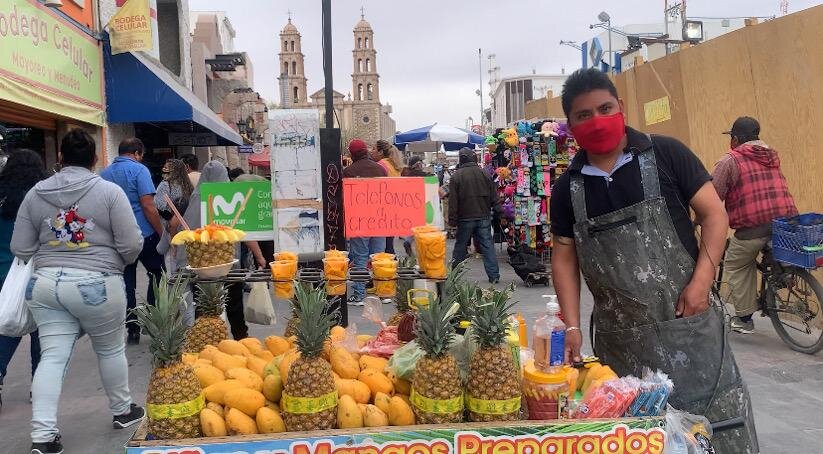A large community of mobile vendors depend on street sales to feed their families in Ciudad Juárez. The covid-19 pandemic disrupted the Mexican economy and threatened disaster for many who don’t hold traditional jobs along the border with Texas. Here is a look at what they were going through in 2021.
“Elotes! Mangos! Baleros!”
This shout-out is what passersby hear as vendors work the streets of Ciudad Juárez or roam the bridges connecting this thriving Mexican border metropolis with its sister city, El Paso, on the other side of the border with Texas.
Vendors selling a variety of goods – purses, porcelain figurines, various candies, and all manner of fast foods – compete for the eyes and ears of local residents and visitors.
A large community of vendors depend on street sales to get ahead or just feed their families. This is why the COVID-19 pandemic, which still holds Mexico in a tragic grip, has disrupted the economy and threatens disaster for many who don’t hold traditional jobs.
“These times have put us in a crisis and it’s all left us without work,” said Saúl Galindo, a Juárez mango vendor. Galindo said this work is what sustains their families.
STREET LIFE
Coronavirus-driven health regulations set last year by the Mexican federal government are tough and have kept many vendors off the streets.
Also, U.S. imposed crossing restrictions set at the start of the pandemic meant the once bustling border town no longer had its usual traffic. The only people who could cross the border were those with medical needs, for work or for school. Green card holders, U.S. citizens and government workers could cross too. This week the U.S. government extended the border controls for at least a month.
This crushed the street-vendor trade because the Ciudad Juárez-El Paso port of entry was the second busiest in the U.S. In 2019, before the pandemic, close to 10 million passenger vehicles travelled northbound to the U.S. Half that number crossed in 2020, according to U.S. government data.

Although crimped by the COVID-19 pandemic and signs barring their presence, street vendors say they must continue to work the lines of hungry, slow-moving border commuters on the Bridge of the Americas connecting Ciudad Juárez and El Paso. Photo by Bryana Andrea Balderrama
And it’s not just the commerce or the money that this traffic brings. Many vendors and their families have come down with COVID-19, as they’re exposed everyday – they say they have to go out and try to sell their goods as no one pays them to stay home. And since many street vendors say they do not have resources for good medical care, they instead treat themselves with home remedies.
“The truth is yes we did catch it … well more than anything we treated it with herbs, tea, and medicine only, it’s not like we went to the doctor… no, pure herbs,” the vendor Galindo said.
Galindo said it is indeed important to respect the regulations that have been implemented by Mexico’s health department. Maintaining a certain distance means avoiding direct contact with clients, and there are even signs on the international crossing bridges warning vendors away from lines of border commuters. But that does not stop vendors from trying to earn their daily living.
ADAPTING TO CRISIS
Many vendors have sought alternatives — new products and second jobs.
“Because I’ve always been a businessman, I looked for other products … I sold face masks and all that in order to maintain my family,” Galindo said.
For people who work the streets selling food, toys, and household goods, maintaining a distance of six feet and always wearing a face mask were things they had to get used to.
Eligio Alcala sells Mexican toys along the border crossing, including “baleros,” a traditional Mexican toy where the player tries to land a wooden block onto a stick, connected by a short string.

Eligio Alcalá and his popular “baleros” – wood blocks on a string that players must flip onto the handle. The pandemic has drastically cut his sales on the Bridge of the Americas, connecting Ciudad Juárez in Mexico and El Paso in Texas. Photo by Bryana Andrea Balderrama
“We have to protect ourselves, wear a face mask and social distance when going to sell something to someone,” Alcalá said.
Before the pandemic, he said, he was able to work more hours on the border’s Bridge of the Americas. Now he works no more than four hours daily. That was about the same amount of time the average driver needed to cross the bridge in heavy traffic.

Customers approach Jose Adrian González, a torta vendor, while following COVID-19 regulations and guidelines. Bryana Andrea Balderrama
Jose Adrian González, 27, a vendor who has been working at the Bridge of the Americas selling tortas for 6 years, described how the pandemic affected his daily pay. “The boss used to pay me 30 dollars daily, but when the pandemic started and sales slowed down, it was 20 to 22.50. But now, thank god, the sales are good, he pays me 34.99,” said González.
Alcalá and vendors like him are keeping an eye on Ciudad Juárez’s municipal palace. During the pandemic the Mexican government began a “stoplight” system to implement restrictions and regulate non-essential economic activities in some states and municipalities. The four metrics to determine the colors in the Mexican government’s stoplight system are the trend in numbers of new cases; hospital occupancy trends; current hospital occupancy rates; and percentage of positive cases.
Once the government gives the green light for businesses to reopen to full capacity, the economy will finally start to rebound, vendors predicted. “The government has seen how the pandemic affected our business and allowed us to sell again, they’ve just asked us to maintain distance, that’s why we have yellow tape around,” said Gonzalez.
Until then, it’s all about finding a way to stay afloat.
“Well yes, we struggle a bit more, we struggle a bit because … there aren’t (the usual border-crossing wait) lines, but still one survives,” Alcalá said.
—
Editor’s Note: This article originally appeared in palabra. It is part of a collaboration with Borderzine and palabra., an initiative of the National Hispanic Journalists Association, palabra. is a multimedia platform which delivers informative journalism, both within a designated platform and syndicated across other platforms to support NAHJ freelance journalist members by providing both a secure platform to share their voice and developmental support.


